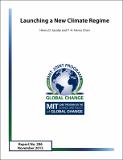| dc.description.abstract | At the 2015 UN Framework Convention on Climate Change (UNFCCC) meeting in Paris, participants in a new international climate agreement will volunteer Nationally Determined Contributions to emissions reductions. To put the planet on a path to declared temperature goals, the growth of global greenhouse gas emissions must cease, and begin to decline, by 2035 to 2040; however, the expected contributions do not yield results consistent with this timeline. Three achievements in Paris and follow-on activities are then crucial components of the new climate regime: a robust system of review with widely accepted measures of national effort; an established, durable plan of future pledge cycles; and increased financial support for the mitigation efforts of less developed countries. The MIT Economic Projection and Policy Analysis (EPPA) model is applied to assess emissions outcomes of expected pledges and national performances in meeting them, and to elaborate the components of a successful launch. | en_US |
| dc.description.sponsorship | The Joint Program on the Science and Policy of Global Change is funded by a consortium of government, industrial, and foundation sponsors (for the complete list see: http://globalchange.mit.edu/sponsors/all). Support from the U.S. Federal Government in the past three years was received from the U.S. Department of Energy, Office of Science under grants DE-FG02-94ER61937, DE-SC0007114, DE-FG02-08ER64597; the U.S. Department of Energy, Oak Ridge National Laboratory under subcontract 4000109855; the U.S. Department of Agriculture under grant 58-6000-2-0099; the U.S. Energy Information Administration under grant DE-EI0001908; the U.S. Environmental Protection Agency under grants XA-83505101-0, XA-83600001-1, and RD-83427901-0; the U.S. Federal Aviation Administration under agreement 09-C-NE-MIT; the U.S. National Aeronautics and Space Administration under grants NNX13AH91A, NNX11AN72G, and subawards 4103-60255 and 4103-30368; the U.S. National Renewable Energy Laboratory under grant UGA-0-41029-15; the U.S. National Science Foundation under grants OCE-1434007, IIS-1028163, EF-1137306, AGS-1216707, ARC-1203526, AGS-1339264, AGS-0944121, and sub-awards UTA08.950 and 1211086Z1; the U.S. Department of Transportation under grant DTRT57-10-C-10015; the U.S. Department of Commerce, National Oceanic and Atmospheric Administration under grant NA13OAR4310084. | en_US |

